Abstract
The paper presents the design and development of a universal simulation model named SustainSIM, intended for optimizing the carbon footprint in mechanical engineering production. The objective of this model is to enable enterprises to accurately quantify, monitor, and simulate CO2 emissions generated during various manufacturing processes, thereby identifying and evaluating effective reduction strategies. The paper thoroughly examines methodologies for data collection and processing, determination of emission factors, and categorization of emissions (Scope 1 and Scope 2), utilizing standards such as the GHG Protocol and associated databases. Through a digital simulation environment created in Unity Engine, the model interactively visualizes the impacts of implementing green technologies—such as solar panels, electric vehicles, and heat pumps—on reducing the overall carbon footprint. The practical applicability of the model was validated using a mechanical engineering company as a case study, where simulations confirmed the model’s potential in supporting sustainable decision-making and production process optimization. The findings suggest that the implementation of such a tool can significantly contribute to environmentally responsible management and the reduction of industrial emissions. In comparison to existing methods such as SimaPro/OpenLCA (detailed LCA) and the Corporate Calculator (GHG Protocol), SustainSIM achieves the same accuracy in calculating Scopes 1/2, while reducing the analysis time to less than 15% and decreasing the requirements for expertise. Unlike simulation packages like Energy Plus, users can modify parameters without scripting, and they can see the immediate impact in CO2e.
1. Introduction
Reducing carbon emissions is currently one of the most pressing trends in business, technology, innovation, and many other sectors. According to scientific studies, carbon emissions and their long-lasting impact, often persisting for hundreds of years, have noticeable effects on the environment, air temperature, overall climate, and the behavior of various complex ecosystems on our planet. Consequently, CO2 emissions leave behind a carbon footprint. Considering that a significant proportion of CO2 emissions are anthropogenic—generated by human activities due to industrialization in developed countries—it is society’s responsibility to minimize the impact of industrialization on CO2 emissions. Research suggests that the effect of technological innovation on CO2 emissions varies depending on a country’s economic development level, highlighting the need for tailored long-term policies that account for these differences [1].
However, a common issue is that developed countries, aware of the existence and causality of carbon footprints, are often not the primary sources of CO2 emissions. Nonetheless, it is necessary to regulate and monitor these emitting activities and find innovative, efficient, and sustainable solutions to reduce CO2 emissions. Various international organizations, negotiations, conferences, and treaties are actively involved, obliging countries to adopt sustainable practices. Advanced computational techniques, such as Multi-Objective Mathematical Modeling, Mixed-Integer Linear Programming (MILP), and Adaptive Fuzzy-Based Particle Swarm Optimization (AFPSO), can help minimize energy consumption, implementation costs, and demand forecast errors while maximizing sustainability. Despite having access to a wide range of technologies that significantly reduce or even negate their carbon footprint, many nations still lag in adopting sustainable innovation projects [2].
This brings us to the issue addressed by this research. Small and medium-sized enterprises (SMEs), from a macroeconomic perspective, may not individually contribute significantly to the carbon footprint, but collectively form a network generating thousands of tons of emissions that could be prevented if provided with practical and low-cost monitoring and optimization tools. Just as decentralizing specific operations in supply chains has been shown to significantly reduce carbon footprint without compromising service levels or lead time, SMEs could benefit from similarly scalable, efficiency-preserving strategies tailored to their collective impact [3].
In line with this, we consider up-to-date scientific approaches and innovative technologies that may aid in developing roadmaps to reduce climate-active gas emissions, control rising temperatures, decarbonize economies, and promote sustainable societal development. Therefore, we have developed a universal simulation and reference digital model for optimizing and managing the carbon footprint in the mechanical engineering sector using available software solutions and accumulated knowledge. Just as dynamic game models compare equilibrium solutions and optimal trajectories across variables like commission rates, our simulation framework identifies emission-reduction pathways by testing scenarios where production parameters, energy sources, and circular economy practices are systematically varied [4,5].
An example of one of the currently employed methods for regulating and detecting CO2 emissions is the CEMS, or Continuous Emission Monitoring System. This system consists of a set of online analyzers (most commonly NDIR or TDLAS lasers) that measure the concentration of CO2 and other gases directly in the flue gas 24 h a day. From the measured concentration and known flow rate of the flue gases, the mass flow of CO2 is calculated every minute. The system complies with the EN 14181 standard [6] for large combustion sources and sectors falling under the Industrial Emissions Directive and the EU ETS. CEMS is one of the most reliable and recognized methods for determining carbon footprints for direct (Scope 1) emissions.
Our innovation regarding the SustainSIM software translates the formal requirements of the GHG Protocol into a clear 3D simulation, combining its own database of emission factors with the temporal logic of production and immediately demonstrating how much CO2 the company produces today as well as how much it saves after implementing solar panels, electric vehicles, or heat pumps. Thanks to these innovations, it offers faster, more accurate, and user-friendly management of the carbon footprint, especially for small and medium-sized engineering companies.
2. Materials and Methods
The carbon footprint, as a metric generated by enterprise activities, can originate from various sources within a company’s operations. Therefore, it is categorized into groups based on characteristics and activities demonstrating positive or negative carbon footprint values. These groups are defined as Scopes and are divided into three categories according to their involvement in the enterprise’s carbon footprint: direct emissions from the company (Scope 1), indirect emissions from the company (Scope 2), and emissions generated throughout the supply or value chain (Scope 3), including all activities occurring before and after active participation in the product’s or service’s lifecycle. These Scopes and corresponding company activities contributing to carbon emissions are illustrated in Figure 1 [7].
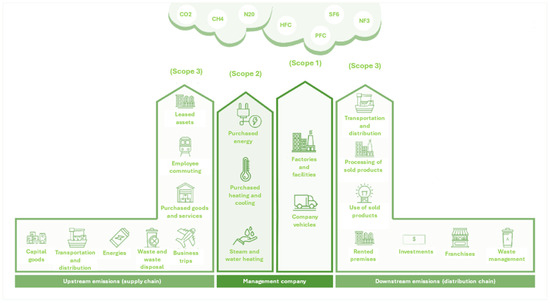
Figure 1.
Carbon footprint scopes, according to the GHG Protocol.
Direct emissions (Scope 1):
- Building heating and cooling: These emissions originate directly from fuels burned onsite for heating, cooling, or hot water generation.
- Transportation: Includes emissions from company vehicles and transportation of materials and products, as well as employee commuting when using company resources.
- Energy consumption in manufacturing processes: Occurs when energy sources (such as natural gas or diesel) are utilized directly on-site.
- Direct emissions from manufacturing processes: Emissions that are not part of energy combustion but are produced directly from chemical or other process activities.
Indirect Emissions (Scope 2):
- Building heating and cooling: Emissions occur if the energy used for heating and cooling is sourced externally.
- Energy used in manufacturing processes: These emissions result from electricity purchased and consumed that is generated off-site.
- Transportation: Includes emissions associated with electricity or other energy sources used for transportation outside the company’s control (e.g., public transport or external carriers).
Other Indirect Emissions (Scope 3):
Several categories for upstream and downstream emissions within the supply chain are summarized in Table 1 and Table 2, according to the standards of the GHG Protocol. Policymakers need to strengthen guidelines around GHG reporting, particularly in standardizing Scope 3 emissions accounting, reporting of parameters outside CO2, and calculation methods [8].

Table 1.
Upstream emissions (supply chain) [9].

Table 2.
Downstream emissions (distribution chain) [10].
Figure 2 illustrates the flowchart of the calculation procedure for emission assessments. This process consists of several interrelated activities, some of which require decision-making steps that directly influence the subsequent calculation results. The key steps and their descriptions are as follows:

Figure 2.
Diagram of the emission calculation process.
2.1. Emission Factors
Emission factors are coefficients that enable the conversion of consumed fuel or energy quantities into the amount of greenhouse gas (GHG) emissions produced. They are expressed in mass units of CO2 emitted per specific energy consumption (e.g., kg CO2e/m3, kg CO2e/kg, kg CO2e/L, kg CO2/mmBtu, kg CO2/MWh, etc.). These factors serve as critical tools for quantifying GHG emissions, as they establish a link between the amount of material or energy used and the emissions generated. Emission factors can vary depending on the type of fuel, technology, facility management, or even geographical location. Industrial parks that integrate industrial and economic resources are priority entities concerning the achievement of national carbon mitigation. They play a significant role in optimizing emissions through better management and technology integration. Emission factors are a fundamental component in carbon footprint calculations. The general formula for emission calculations is presented in Figure 3 [10].

Figure 3.
General simplified formula for emission calculation.
The equation presented in Figure 3 illustrates the standard method for estimating carbon dioxide (CO2) emissions associated with industrial activities:
- Operation refers to the quantitative measure of a specific production activity or process. This can include machine runtime (in hours), number of produced units, fuel consumed (in liters or kWh), or any other operational metric relevant to the production process being analyzed.
- Emission factors are typically sourced from national or international databases that have been compiled and verified through scientific studies or regulatory bodies. Examples include the official Greenhouse Gas Protocol, which provides various emission factors, as well as databases available on platforms such as the European Commission or the European Environment Agency. Additionally, the Intergovernmental Panel on Climate Change (IPCC) publishes comprehensive emission factor databases.
Carbon neutrality (CN) involves achieving a balance between carbon emissions and carbon absorption, with the goal of reaching net-zero emissions by using carbon sink mechanisms to absorb atmospheric carbon. It is crucial to select the most appropriate factor based on available information and the specific context of emission measurement [11].
An operation can be understood as any activity that directly or indirectly generates a carbon footprint. An operation can contribute to the carbon footprint from multiple sources. For most small and medium-sized enterprises (SMEs), Scope 1 greenhouse gas emissions are calculated based on purchased fuels such as natural gas or heating oil, using published emission factors. Scope 2 emissions are determined from measured electricity consumption and supplier- or location-specific emission factors. Scope 3 emissions result from activities beyond operational boundaries, such as fuel consumption by suppliers or transport distances, with published emission factors used for these variables. The global trend of reducing the ‘carbon footprint’ has influenced the dynamic development of projects that use renewable energy sources, including the development of solar energy in large solar power plants. Where available, facility-specific emission factors are preferred over general factors. Industrial companies should seek sector-specific guidelines from industry associations or the GHG Protocol website [12].
2.2. Proposal for a Reference Simulation Model
Current solutions for carbon footprint simulation are highly limited. Emission calculations rely on tools and advanced spreadsheets, such as the “GHG Emission Calculation Tool” in Microsoft Excel, as well as various information systems. However, these solutions lack visual interfaces and simulated environments. Several software solutions are available for monitoring and managing carbon emissions, but they are typically focused on data collection and static reporting rather than interactive analysis. Given the growing importance of addressing climate change, it is becoming increasingly urgent to select eco-friendly energy sources for future energy demand. This highlights the need for more advanced, dynamic tools in carbon footprint management [13].
Available solutions for engineering companies include:
- GHG Protocol Tools:These tools offer various calculation spreadsheets to estimate greenhouse gas emissions by sector [14].
- SimaPro:A life cycle assessment (LCA) software that enables a detailed evaluation of a product’s environmental impact. Although highly comprehensive, its complexity and lack of a visual interface may make it impractical for most engineering firms [15].
- OpenLCA:Another LCA tool that is free and flexible but still requires significant technical expertise and does not include an advanced visual interface [16].
Due to these limitations, we have chosen to develop a carbon footprint simulation tool using Unity Engine, as we believe that an interactive visual interface will provide a better user experience and facilitate an intuitive understanding of data. The Unity Engine enables the creation of dynamic simulations and visualizations, allowing users to see how various factors influence the carbon footprint in a clear and engaging manner.
2.2.1. Application Model Name: SustainSIM™ 2.1
The objective of the SustainSIM model is to enhance the availability of tools for quantifying, simulating, and optimizing the carbon footprint of engineering companies, thereby contributing to cost reduction. This universal digital tool with a visual interface will enable business managers to accurately outline the current carbon footprint generated by company processes. Through simulations of green technology implementation, it will also help identify weak points in production, allowing for targeted change management in manufacturing systems where it is most effective. The model further enables the quantification of differences in carbon footprint generation before and after a change. SustainSIM focuses on a user-friendly interface that supports informed decision-making and contributes to achieving carbon neutrality and compliance with ISO standards.
2.2.2. Software: Unity 3D (2023.3.x)
This software is well-suited for creating simulations and visualizations and is widely used in industrial applications. It allows developers to design complex environments for simulating various processes and scenarios. The software supports scripting in C# and JavaScript, as well as visual scripting, providing developers with the necessary tools to create complex interactive experiences and simulations. Scripting enables the simulation of dynamic system behaviors, such as energy consumption and CO2 emissions, effectively in real time, making it a perfect match for the objectives of the proposed model [17].
2.2.3. Methodology for Designing the SustainSIM Model
When designing the SustainSIM model, the primary focus was on key aspects essential for the quantification and optimization of the carbon footprint in engineering companies. The model includes calculations of CO2 emissions from various sources, including fuel and electricity consumption, as well as simulations of the impact of implementing green technologies such as solar panels. Given the scope of this publication and the effort required for data collection, we have decided not to incorporate time-related implications of Scope 1 emissions into the model but to include only the monthly reference number of emitted CO2 units. However, the model still allows for proportional quantification of emissions for a given period.
This decision was made based on the model’s purpose, which is to serve as a reference tool for monitoring and reducing the carbon footprint rather than for detailed economic analysis. Capacity and cost considerations can be complex and often depend on numerous variables not directly related to emission calculations. The quantification and simulation of emission reductions remain our primary focus. Therefore, we leave these calculations to specialized tools and experts who conduct economic and capacity analyses, as we do not have sufficient resources for such model development. Instead, the model represents a conceptual pre-alpha version of the software.
Due to similar resource limitations, certain business activity data that could be crucial for simulation will be input as variables based on historical activity data or derived from other simulation tools for specific activity intervals. Emission factors will still be converted to CO2e and will not include reports on the shares of individual greenhouse gases within carbon emissions. For our purposes, we will use emission factors from the GHG Protocol, specifically those listed in their calculation tool, converted into standard units used in European countries.
2.3. Simulation of the Carbon Footprint from Electricity Consumption
For the methodology of calculating Scope 2 emissions in the SustainSIM model, two approaches are available: location-based and market-based, as defined earlier. Given the complexity of the market-based Scope 2 calculation methodology, we have opted for the location-based approach. This method calculates emissions based on average emission factors for electricity in a given geographical region, increasing the model’s applicability in different geographic locations.
For this purpose, relevant data for individual countries were sourced from the appropriate database, enabling accurate and consistent CO2 emission calculations. The location-based method allows for easy data integration, ensuring that the designed application remains user-friendly and accessible to a wide range of engineering companies. To simulate the carbon footprint from electricity consumption using this method, it is necessary to obtain average emission factors for specific electricity grids in various locations. The relevant document containing these emission factors is officially available for European countries on the European Commission’s website in the Joint Research Centre Data Catalogue section [18,19].
The model requires selecting a country, and based on this selection, the consumed energy will be multiplied and simulated using a local database, drawing data from the mentioned source. This database contains different factors for electricity-generated emissions per country, based on the average CO2e values per unit of electricity. These values account for the share of energy production methods in a given country and their associated carbon footprint.
2.4. Organizational and Operational Boundaries
The organizational boundaries in the model were defined based on financial control, ensuring that companies using the tool do not face difficulties when simulating operations over which they lack control. If a company holds an equity stake in another company, it only has marginal control over its operations and may not have access to the necessary documentation for data collection.
The operational boundaries in the model are similarly restricted to operations closely related to the company’s activities. Thus, only direct and indirect emissions of the company using the tool (Scope 1 and Scope 2) are included in the model. Upstream and downstream emissions will be omitted due to the characteristics of Scope 3, as well as the objective of this publication—to achieve a simple visual representation of the carbon footprint. Based on this, it was decided that the application model will not include calculations for Scope 3 [20].
2.5. Emission Factor Database
For simulation purposes, it is necessary to transform numerical input attributes into outputs. However, for functionality purposes, it is not required to link SustainSIM to online databases; instead, a local database of emission factors included in the algorithm’s attributes will suffice.
Table 3, Table 4 and Table 5 presents emission factors converted into units used in the European Union, sourced from the GHG Protocol calculation tool database and the European Commission’s database of electricity consumption emission factors for Europe mentioned earlier. Standardized unit values were used for converting emission factors into units commonly applied within the EU.

Table 3.
Converted emission factors for stationary combustion: Scope 1 [8].

Table 4.
Converted emission factors for mobile combustion [8].

Table 5.
Emission factors for electricity in neighboring countries for Scope 2.
Example of Factor Conversion:
Given values for gasoline mmBtu/gallon = 0.125 (million British thermal units per 3.7854 L)
Attributes will be assigned a level according to the following conceptual map (Figure 4), where the highest level represents the number of tons of CO2 emissions for a given object, Scope, activity, etc.
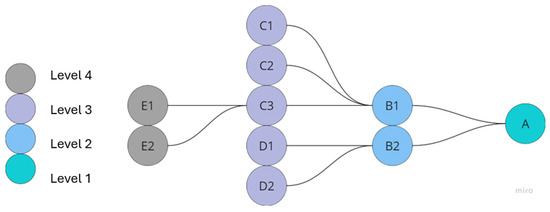
Figure 4.
Concept map of the algorithm and attribute hierarchy in the algorithmic model.
2.6. Simulation Algorithm Map
In the background of the universal model, carbon footprint generation will be simulated on a time-based scale. As with any simulation, it is necessary to define the relationships between variables and other interconnections. Therefore, an algorithm was chosen that defines a large number of relationships between variables based on hierarchical structuring (Figure 5) when designing logical relationships between variables and time. The basic time unit is defined as one hour, and the map is structured accordingly, incorporating unit conversions per hour.

Figure 5.
Mind map of the algorithm.
The algorithm map visualizes the processes of CO2 generation and reduction in the context of engineering companies. On the left side of the map, the attributes related to CO2 generation are hierarchically arranged, including stationary and mobile combustion (Scope 1) and electricity consumption by machinery (Scope 2). For each fuel type, recorded data include the volume of fuel consumed, number of operating hours, fuel consumption per hour, and emission factor. Additionally, the model tracks operating time, utilization rate, and maximum power capacity to calculate total electricity consumption and resulting CO2 emissions.
On the right side of the map, CO2 reduction methods are displayed, such as the use of electric vehicles, heat pumps, and solar panels. These methods incorporate factors such as energy consumption, electricity emission factor, and performance coefficient, which are essential for calculating emission reductions.
The map comprehensively visualizes the data flow and relationships between various variables that are essential for the quantification and optimization of the carbon footprint in engineering companies and for designing the proposed model. Connections between databases also play a crucial role and cannot be overlooked.
We considered other modeling approaches such as regression models and black-box simulations; however, these methods often mask the internal logic of CO2 interactions and make it difficult to visualize how individual factors contribute to emissions and reductions.
2.7. Software Design
The description of the SustainSIM model will not follow the steps of the development process but will be structured based on the functions and their corresponding features. The development was conducted using the C# programming language and visual scripting. The algorithm map from Figure 5 guided the process, ensuring a clear distinction between user-inputted values and those that are calculated, simulated, or pre-defined in sequence.
User Interface
This section describes the design, windows, and various elements with which the user will interac (Figure 6)

Figure 6.
Design of the introduction screen.
- Introduction Screen: This involves creating the graphical user interface for the simulation, including the startup menu, the main menu, and the integration of buttons or cursor interactions with objects.
- Company Name: The name of the company utilizing the simulation and calculation tool.
- Company Location: After entering the company name, the user selects the country. This is essential for the emission simulation properties, as emission factors are determined based on location, specifically using the average factors for the entire electrical grid of Slovakia. These factors are sourced from the emissions factor database created for the simulated model.
- “Continue” Button: Button that triggers an event, switching to the next screen.
Main Screen
The next screen after entering company and country data provides several pieces of information and options, allowing the user to navigate through different sections of the model. Interaction with various sections is implemented using raycasting and a click script. This screen can be defined as the Main Menu of the Software (Figure 7).
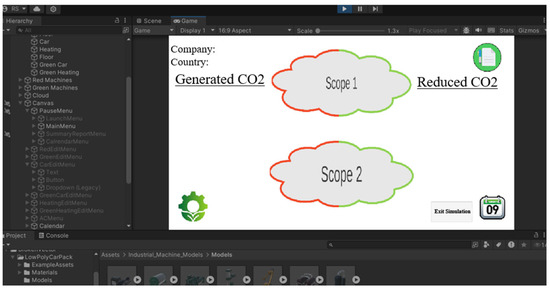
Figure 7.
Main menu of the model.
As seen, there are several interaction options and subsections available. Below is a description of each section, along with its attributes and functions.
Scope 1
The Scope 1 button (Figure 8) directs the user to an interface where they can define and input attribute values for stationary and mobile combustion. Additionally, users can set parameters for simulating CO2 emission reductions under specific user-defined conditions.
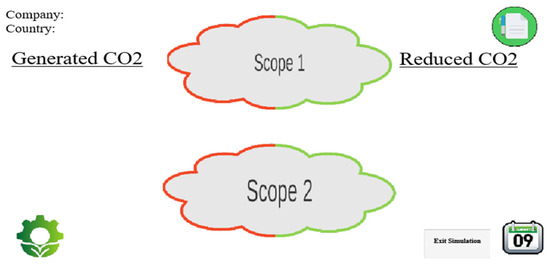
Figure 8.
Main menu section.
Scope 2
The Scope 2 button (Figure 8) navigates the user to a graphical interface for entering attribute values related to the generation and reduction of Scope 2 emissions in one place. Here, the user will be able to define attributes for machines used in engineering production and simulate the impact of adding solar panels, purchasing electricity from green sources, and other related factors on emissions.
Calendar
The simulation interval input is assigned to the Calendar section. The functionality of the calendar is to specify the simulation interval in days for calculating the following variables:
- (a)
- Simulation Interval: Units entered in the simulation as time units will be expressed in days.
- (b)
- Number of Shifts: Defined as a whole number, this represents the number of work shifts performed daily in the company.
- (c)
- Shift Duration: Specifies the time interval defining a single work shift.
- (d)
- Summary of Results: The icon on the right navigates to the Results Summary menu.
2.8. SustainSIM—Scope 1
Pressing the Scope 1 button in the main menu navigates to the Scope 1 interface (Figure 9). This interface consists of models for simulating emission generation and simulating emission reduction.
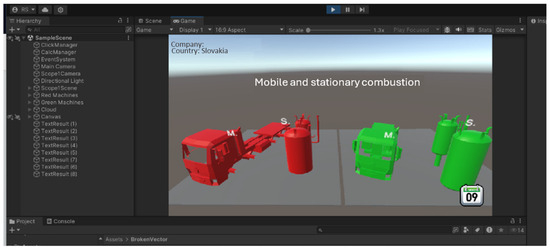
Figure 9.
Interface for Scope 1.
Each section includes one model for stationary combustion and one for mobile combustion. Since the design of Scope 1 emission simulations considered both types of combustion, two models were created to represent these functions. Mobile combustion is represented by a truck, while stationary combustion is represented by a boiler room.
2.8.1. Design and Methodology for Simulating Scope 1 Emission Generation
After adding the models, functionality was defined using a script that triggers a context window for data input upon clicking (Figure 10). The data and relationships between them are described in the algorithm map in the relevant section.

Figure 10.
Context windows for Scope 1 emission generation.
Attributes:
- Mobile Combustion
- -
- Total Fuel Volume: The amount of fuel consumed over a specific time interval.
- -
- Fuel Type: The type of fuel used as the basis for emission calculations.
- -
- Number of Vehicles: The number of vehicles consuming the fuel or actively operating in the company.
- Stationary Combustion
- -
- Total Fuel Volume: The amount of fuel consumed over a specific time interval.
- -
- Fuel Type: The type of fuel used as the basis for emission calculations.
Emission factors are defined in the ClickManager script.
2.8.2. Design and Methodology for Simulating Scope 1 Emission Reduction
In the emission reduction simulation, after creating and assigning functionality to the models (e.g., context windows, attributes, values), the models were linked to generated emissions. Through defined relationships, CO2 emissions from combustion processes were proportionally reduced. To decrease emissions from mobile combustion, a feature was added to simulate replacing a certain number of internal combustion engine vehicles with electric vehicles, thereby proportionally reducing CO2 emissions. In the simulation model, this reduction is assumed to be time-linear and evenly distributed across all vehicles. For stationary combustion emission reduction, heat pump technology was implemented. A simple coefficient (ranging from 0 to 1 or expressed in percentages) was used to represent the reduction in energy consumption compared to traditional combustion methods. During modelling and programming relationships, the algorithmic map was followed, where emission reductions for heat pumps are simulated using a coefficient that reduces energy consumption compared to stationary combustion.
Attributes:
- Number of electric vehicles replacing conventional vehicles,
- Energy consumption reduction coefficient.
2.8.3. Design of Scope 2 Emission Generation Simulation
For the emission generation functionality, instead of allowing users to add custom machines, a selection of predefined machines is available. Users can assign activity data by clicking, which is then stored and used for time-based CO2e generation simulation for a given production process. Machines were assigned general attributes that allow the quantification of electricity consumption in relation to production and specific processes.
Attributes:
- Machines in the Process
- -
- Utilization rate: The percentage of time the machine operates at maximum capacity.
- -
- Power rating: The machine’s operational power output.
- -
- Name: A machine description for better clarity.
- HVAC system
- Hourly average HVAC consumption
- -
- Theoretical median energy consumption of the HVAC system during the defined simulation period.
2.8.4. Design of Scope 2 Emission Reduction Simulation
For emission reduction, data input for production emission calculations follows a similar structure to emission generation. A fixed selection of green technologies is available, where each technology represents an independent solar circuit of multiple solar panels. All solar panels are assumed to have a 30° tilt, facing south to ensure optimal energy generation. The defined variables follow the algorithmic map, linking them to other factors according to established relationships. In the HVAC system context window, the difference between theoretical old and new hourly average energy consumption is used to calculate CO2e reductions from HVAC systems. Theoretically, these attributes could be modified to represent other green technologies or to simulate the partial reduction of Scope 2 emissions through sustainable energy procurement strategies.
Attributes:
- Solar Panels
- -
- Number of solar panels in the circuit: The number of solar panels in the system.
- -
- Power rating: The operational power output.
- -
- Name: A machine description for better clarity.
- HVAC system
- New hourly average HVAC consumption
- -
- New theoretical median energy consumption during the defined simulation period.
Scripts:
The software contains multiple scripts, each fulfilling specific tasks related to execution, activation, and control of operations.
Menu:
The Menu script manages basic menu navigation, allows for pausing and resuming the simulation, controls cursor visibility, and ensures that the simulation progresses or pauses smoothly. This script is essential for maintaining a seamless user experience, allowing users to pause, make necessary adjustments, and resume the simulation without disruptions.
Machine and GreenMachine
These scripts define variables and attributes for Scope 2 emission-generating objects.
- (a)
- Machine Script: Calculates machine power output based on utilization rate and maximum power.
- (b)
- GreenMachine Script: Ensures accurate energy output calculations for solar devices and their conversion into reduced emissions.
These scripts work together to ensure a smooth simulation flow, providing users with tools to monitor and manage performance and energy efficiency.
Functions:
- (a)
- Machine
- -
- Calculation of machine power output and reduction performance.
- -
- The script computes the machine’s final power output based on current utilization and maximum capacity.
- -
- Defines machine attributes.
- (b)
- Quantification of Solar Panel Reduction
- -
- The script calculates the final power output of solar panels and, using the emission factor database, determines the reduction in emissions.
- -
- Defines solar panel attributes.
Cloud
The Cloud script handles the calculation and display of total CO2 emissions generated and reduced within the simulation. It collects data from multiple machines and updates text fields displaying generated and reduced emissions. In the algorithmic map, this script is represented as a cloud node, aggregating data from hierarchically lower attributes. It contains the formula for calculating total emissions from lower-tier variables.
Functions:
- -
- Collection and summarization of data from different machines.
- -
- Calculation of total emissions and reductions.
- -
- Displaying results.
- -
- Linking with other scripts.
- -
- Updating data.
CalcManager
The CalcManager script handles all complex calculations needed for the simulation, from low-level attributes to the second level, including the calculation of total CO2 emissions, both generated and reduced. It also updates summary text fields in the user interface for each emission scope. This script is essential for accurate simulation functionality, as it gathers data from multiple scripts, combines them into final results, and ensures real-time updates in the summary interface.
Functions:
- -
- Calculation of emissions and reductions.
- -
- Data retrieval.
- -
- Updating the user interface and data.
- -
- Managing HVAC input fields.
ClickManager
The ClickManager script enables interactions with the model, such as clicking and setting various values. This script contains the database of emission factors, compiled from converted emission factor data in the “Model Design Methodology” section. It uses two cameras for different perspectives in the simulation (Scope 1 and Scope 2 3D interfaces). It also collaborates with the Menu script, monitoring the states of context windows, updating model statuses, and synchronizing user interactions via raycasting. Additionally, this script contains references to context windows, specifically text fields for data input. These fields are defined within the script and linked to UI values, ensuring that almost all context windows display user-modifiable data. By implementing value retention and restoration, the script ensures smooth and seamless emission reduction simulations.
Functions:
- -
- Collecting and updating data from all scripts and compiling results into the summary.
- -
- Quantifying relationships between attributes based on the algorithmic map.
- -
- Calculating CO2 emissions from vehicles and heating.
- -
- Computing emission reductions for green technologies (electric vehicles, green heating).
- -
- Total CO2 emissions calculation based on working hours, shifts, and simulation days.
- -
- Displaying final results.
Calendar
The Calendar script manages the work schedule in the simulation. Users can set the number of working days, shifts, and hours, which are then used in other parts of the application for calculations and simulations. It defines fields for entering and calculating time intervals in hours, using three main attributes:
- Simulation duration in days
- Number of shifts per day
- Number of hours per work shift
The Results Summary (Figure 11) is designed to provide users with a comprehensive overview of the current carbon footprint status. It is one of the most critical parts of the software, compiling quantified simulation results, along with various indicators of shares, efficiency, and numerical values.
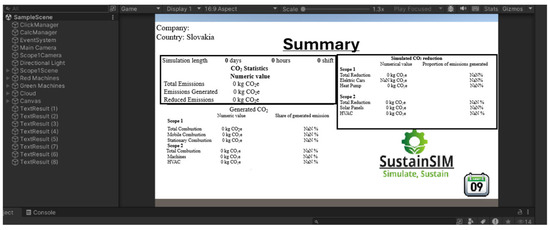
Figure 11.
Menu: Results Summary.
Sections:
- Time Report: The duration of the simulation is expressed in days, hours, and shifts.
- CO2 Statistics: Key statistics on CO2 emissions, such as total emissions, generated emissions, and reduced emissions.
- Generated CO2: This section categorizes CO2 emissions by scope and source, displaying numerical values and their share of total generated emissions.
- Simulated CO2 Reduction: This section presents CO2 emission reductions achieved through various measures, along with numerical values and their share of total emissions.
CO2 Statistics:
- Total Emissions: The total amount of CO2 emissions (in kgCO2e).
- Generated Emissions: The amount of CO2 emissions generated during the simulation.
- Reduced Emissions: The amount of CO2 emissions reduced during the simulation.
Generated CO2:
Scope 1:
- -
- Mobile Combustion: Emissions from mobile combustion sources.
- -
- Stationary Combustion: Emissions from stationary combustion sources.
Scope 2:
- -
- Machine 1, Machine 2, …: Emissions generated by individual machines.
Simulated CO2 Reduction:
Scope 1:
- -
- Electric Vehicles: Reduction of CO2 emissions through electric vehicles.
- -
- Heat Pumps: Reduction of CO2 emissions using heat pumps.
Scope 2:
- -
- Solar Panels: Reduction of CO2 emissions using solar panels.
Value Format:
- -
- Numerical Value: The exact emission value in kg CO2e.
- -
- Share of Emissions: The percentage share of this value in total generated emissions.
2.9. Implementation of a Universal Reference Digital and Simulation Model for a Specific Process
The test engineering company currently operates several concurrent production processes. In VOMAS, Ltd., located in Levoča, Slovakia, a group manufacturing system is implemented, optimized for batch processing of parts with similar production requirements. This system is organized in such a way that groups of parts with similar technological, geometric, weight, and other characteristics are processed together. The purpose of this organizational structure is to increase production efficiency, as parts follow a similar sequence of operations in small to medium production batches.
Due to the group-based organization of production operations, processing times for individual batches at workstations vary, as do the number of parts and the time required for each step or operation. This variability is natural, as even within the same group, parts may require different modifications or time allocations on specific machines depending on their unique properties. Each batch is fully processed at one workstation before being transferred to the next, meaning that material moves sequentially through different phases of production in batch form. This approach enables VOMAS, Ltd. to flexibly respond to demand fluctuations and adjust production plans according to current needs.
To simulate carbon footprint reduction and apply the SustainSIM model for optimizing CO2 emissions, we selected a well-established and long-running process within the company. This allows us to leverage existing company experience with the process and product, ensuring data reliability and easier verification of results.
Production Process
Figure 12 illustrates the material flow and operations of the production process for the trailer reinforcement plate bracket. The process begins with stocking semi-finished materials, specifically steel sheets according to standard specifications and dimensions. Next, a laser cutting machine performs the cutting operation (activity data detailed below). After this step, the bending operation is carried out using a press brake machine, forming the part into the required shape. All these steps occur within the operational boundaries of the company. However, the company outsources the powder coating process to an external supplier, which operates outside the operational boundaries of VOMAS, Ltd.

Figure 12.
Diagram of material flow with operational boundaries representation.
2.10. Machines Within the Operational Boundaries of the Company’s Production Process
Laser Cutting
The cutting machine (Table 6) is paired with additional support units, including an extractor, or a smoke and dust extractor (Table 7), one cooling unit (Table 8), and a press brake (Table 9) (Figure 13). As support units of the process, they must be included in the simulation.

Table 6.
Basic technical data.
Table 6.
Basic technical data.
| Model | Bodor P3 |
|---|---|
| Working Area | 3048 mm * 1524 mm |
| Laser Power | 24,000 kW |
Smoke and Dust Extractor:
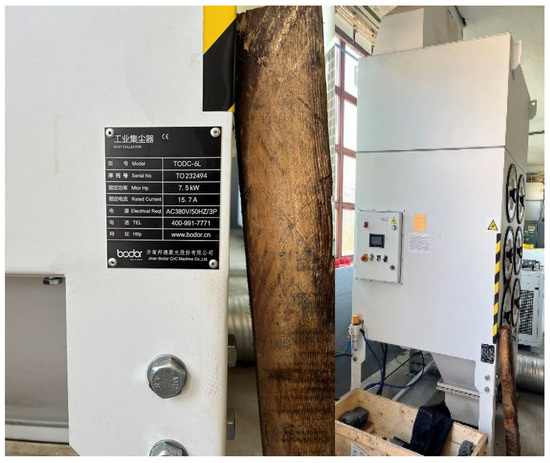
Figure 13.
Smoke and dust extractor.

Table 7.
Basic technical data.
Table 7.
Basic technical data.
| Model | TODC-6L |
|---|---|
| Number of Filter Cartridges | 6 |
| Airflow Rate | 4000 m3/h |
| Air Pressure | 3600 Pa |
| Filtration Efficiency | 99.99% |
| Filter Surface Area | 120 m2 |
| Fan Power | 7.5 kW |
| Waste Collection Container Capacity | 50 L |
| Power Supply | 400 V |
The cooling unit is depicted in Figure 14.
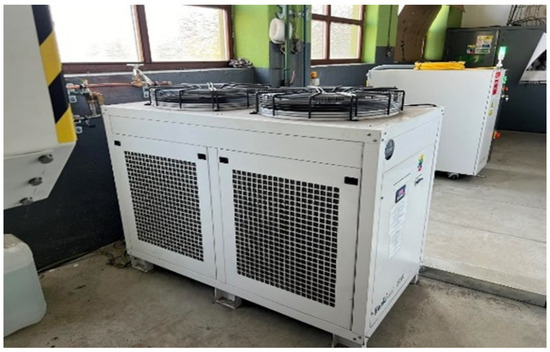
Figure 14.
Cooling unit.

Table 8.
Basic technical data.
Table 8.
Basic technical data.
| Model | HL-20000-QG2/2 |
|---|---|
| Voltage and Frequency | 3 phases, 380 V, 50 Hz 3 phases, 380 V, 60 HZ |
| Maximum Current | 40.0 A |
| Rated Power | 28.1 kW |
| Horsepower | 13 horsepower/15 hp |
The press brake is depicted in Figure 15.
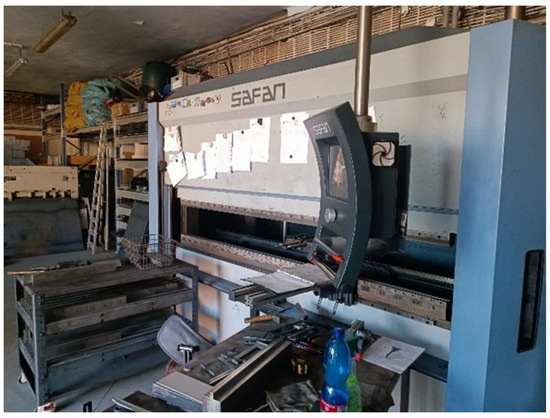
Figure 15.
Press brake.

Table 9.
Basic technical data.
Table 9.
Basic technical data.
| Maximum Bending Length | 2550 mm |
|---|---|
| Maximum Pressing Force | 80 T |
| Speeds | Approach Speed: 115 mm/min Working Speed: 90 mm/min Return Speed: 100 mm/min |
| Power Consumption | 11 kW |
Model Application
This section describes the application of the model to the production process of the selected product to verify whether the model is universally applicable for simulating CO2e emission reductions in an engineering company. The output from this section will be used to validate the model’s functionality by comparing its quantification with conventional methods.
Data Collection on Activity and Parameters
Scope 1
Given the current functionality of SustainSIM, we requested the company to provide data on the monthly consumption of relevant fuels in Scope 1, and it was necessary to incorporate a proportional share into the process simulation. These data were subsequently compiled into Table 10.

Table 10.
Activity data: Scope 1.
Table 10.
Activity data: Scope 1.
| Stationary Combustion | 403 | kWh | Natural Gas |
|---|---|---|---|
| Purchased Fuel (Gasoline) | 540 | L | Gasoline |
| Number of Working Days in the Month (June) | 25 | days | |
| Number of Hours per Working Day | 8 | h | |
| Share of Monthly Scope 1 Activities in the Process | 16.34% | ||
| Stationary Combustion Share-Based Contribution | 65.85 | kWh | |
| Purchased Fuel (Gasoline) Share-Based Contribution | 88.24 | L |
Scope 2
The activity data are a combination of data provided by VOMAS, Ltd. and our own measurements and interpretations of the data. In Table 11, you can see different text formatting of some data. For better understanding, the data were divided into those provided by VOMAS, Ltd. or obtained by our own measurements (bold-lettered), and those that we had to calculate by deriving from these data (normal-lettered).

Table 11.
Scope 2 activity data: VOMAS, Ltd.
Table 11.
Scope 2 activity data: VOMAS, Ltd.
| Laser Cutting Machine | Numerical Value | Unit |
|---|---|---|
| Maximum Power | 24 | kW |
| Actual Cutting Power | 1.4297 | kW |
| Utilization Rate | 90% | |
| Production Capacity of the Operation | 153 | pcs/h |
| Actual Power (%) | 5.96% | |
| Smoke and Dust Extractor | ||
| Power | 7.5 | kW |
| Actual Power (%) | 5.96% | |
| Actual Power | 0.447 | kW |
| Utilization Rate (Operating Time) | 100% | |
| Cooler | ||
| Maximum Power | 28 | kW |
| Actual Power | 1.67 | kW |
| Share of Total Power | 5.96% | |
| Utilization Rate (Operating Time) | 100% | |
| Press Brake | ||
| Power | 11 | kW |
| Utilization Rate | 70% | |
| Production Capacity of the Operation | 200 | pcs/h |
| Share of Press Brake Operating Time in Production | 76.50 | |
| Production Process | ||
| Monthly Production | 5000 | pcs/month |
| Number of Operating Hours of the Laser Cutter | 32.68 | h |
| Number of Operating Hours of the Press Brake | 25 | h |
| Share of Laser Cutter in Production | 100% | |
| Share of Press Brake in Production | 76.5% | |
| Number of Working Days (8 h) Required for Production | 4.0849673 |
The press brake operates at 100% power throughout its utilization period; however, for the simulated model, the actual power value is adjusted based on the share of the press brake in total production time.
Parameters That Required Calculation
Share of Total Laser Power:
Maximum Laser Power/Actual Laser Power × 100% = 5.96%
The power shares of supporting machines are directly proportional to the power of the main machine, and their consumption will be calculated in the same way as for the laser cutting machine—using the coefficient of actual power to maximum power (5.96%).
Actual Power of the Smoke and Dust Extractor:
This power is proportional to the power of the laser head, with 100% utilization, as it operates continuously.
Max. Power × 5.96% = 0.447 kW
Actual Power of the Cooler:
This power is proportional to the power of the laser head, with 100% utilization, as it operates continuously.
Max. Power × 5.96% = 1.67 kW
Share of Press Brake in Production:
Since simulation by pieces was not included, actual power parameters can be replaced by proportional time in percentages based on the total simulation duration, which equals the laser operating time.
Share of Press Brake in Production = (Press Brake Operating Time for 5000 pcs/Laser Operating Time for 5000 pcs) × 100 = 76.5%
Model Application and Data Input
For the calculation of generated emissions, collected company activity data were used (Table 12). For emission reduction simulation, solar panel technology was selected. The simulation will then calculate how much the carbon footprint generated by the process would be optimized if 10 solar panels were installed on the roof, assuming the technology is paired with an energy storage system and experiences no losses. The section below illustrates the process of simulation and calculation of emissions and their reduction using the SustainSIM model (Figure 16, Figure 17, Figure 18, Figure 19, Figure 20, Figure 21 and Figure 22).

Table 12.
Data input for the model.
Table 12.
Data input for the model.
| Machine | Maximum Power (kW) | Actual Power (kW) | Utilization | Production Capacity (pcs/h) | Actual Power (%) | |
|---|---|---|---|---|---|---|
| Laser Cutting Machine | 24 | 1.4297 | 90% (0.9) | 153 | 5.96 | |
| O1 | Smoke and Dust Extractor | 7.5 | 0.447 | 100% (1) | - | 5.96 |
| Cooler (Including Pump) | 28 | 1.67 | 100% (1) | - | 5.96 | |
| O2 | Press Brake | 11 | m. 76.50% | 70% (0.7) | 200 | - |
Note: m. = modified.
Procedure:
Scope 1
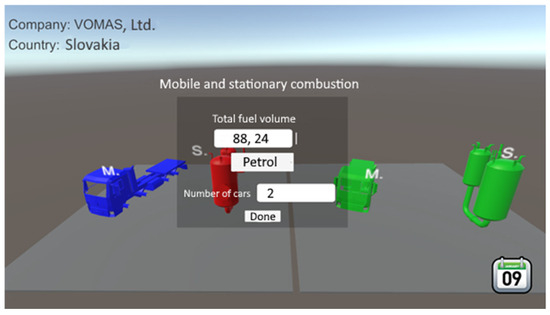
Figure 16.
Input of data for mobile combustion.
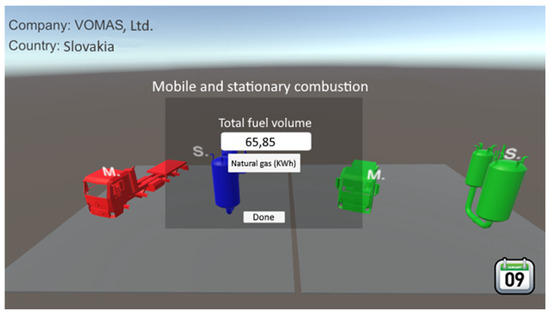
Figure 17.
Data for stationary combustion.
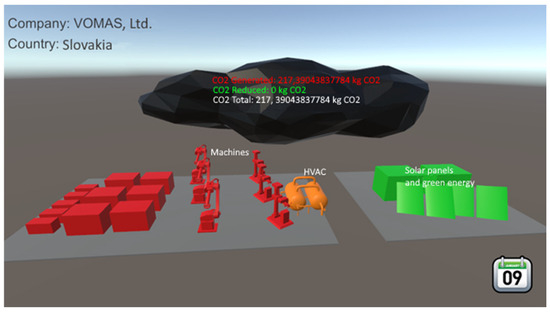
Figure 18.
CO2 emissions from stationary combustion.
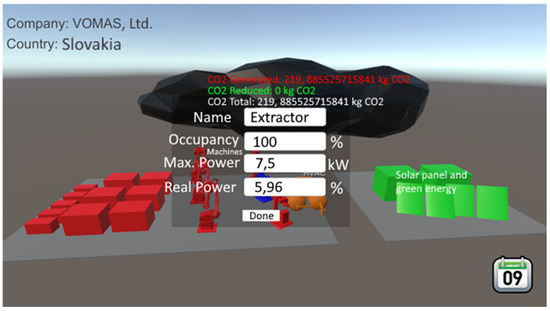
Figure 19.
Input of data for laser.
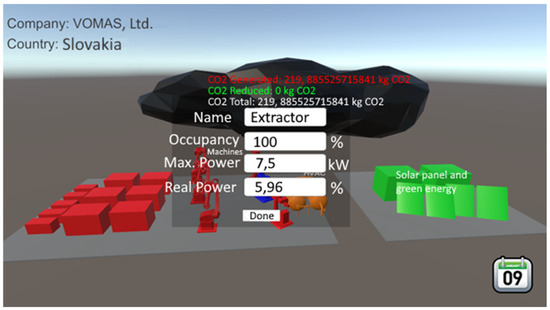
Figure 20.
Data for smoke and dust extractor.
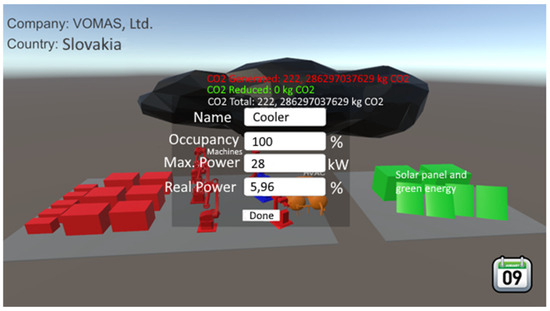
Figure 21.
Data for cooler.
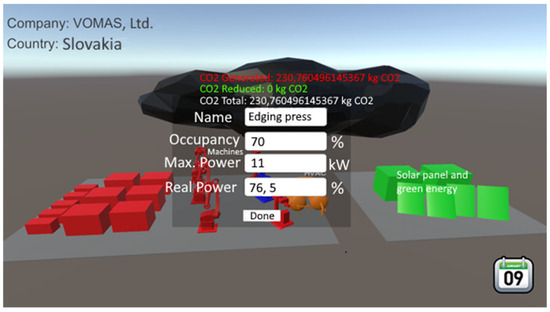
Figure 22.
Input of data for press brake.
Simulation of CO2 Emission Reduction in the Process
For the emission reduction simulation, solar panel technology was selected. The objective of the simulation was to quantify the reduction in the carbon footprint generated by the process with the installation of ten solar panels (Table 13) on the roof. It is assumed that the technology will be integrated with an energy storage system and that no energy losses will occur.
For the reduction, the following monocrystalline solar panel was selected (Figure 23).
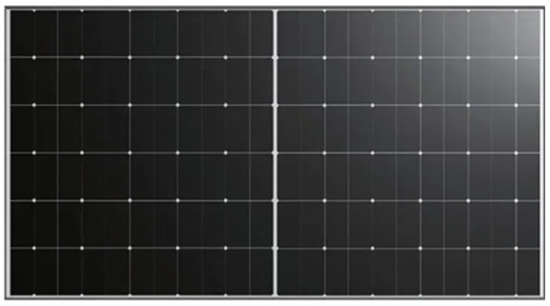
Figure 23.
Monocrystalline solar panel: Longi 520Wp Hi-MO 6, Black Frame.

Table 13.
Technical specifications.
Table 13.
Technical specifications.
| Model | Longi 520Wp Hi-MO 6 |
|---|---|
| Mechanical Properties | |
| Dimensions | 2094 × 1134 × 35 mm |
| Weight | 26 kg |
| Number of Cells | 6 × 22 (technology HPBC) |
| Cell Surface | 3.2 mm tempered glass |
| Durability | IP68 (junction box) |
| Connection Type | MC4 |
| Output Cable | 4 mm2 |
| Frame Colour | black |
| Electrical Properties | |
| Maximum Power | 520 Wp |
| Open-Circuit Voltage | 47.58 V |
| Short-Circuit Current | 14.05 A |
| Maximum Voltage | 39.91 V |
| Maximum Current (Imp) | 13.03 A |
| Efficiency | 21.9% |
| Power Tolerance | 0~3% |
| Operating Conditions | |
| Maximum System Voltage | 1500 VDC |
| Operating Temperature | −40~+85 °C |
| Maximum Snow Load | 5400 Pa |
| Nominal Operating Cell Temperature (NOCT) | 45 °C +/− 2 °C |
Data Input
For the emission reduction simulation, the following parameters were selected (Table 14).

Table 14.
Variables for solar panel emission reduction calculation.
3. Results
After inputting all data (Figure 24), CO2 emissions were calculated using the SustainSIM model. To verify the accuracy of the model, it is necessary to manually calculate the emission data. The section below presents the manual CO2 emission calculation for the production process of the trailer reinforcement bracket at VOMAS, Ltd.
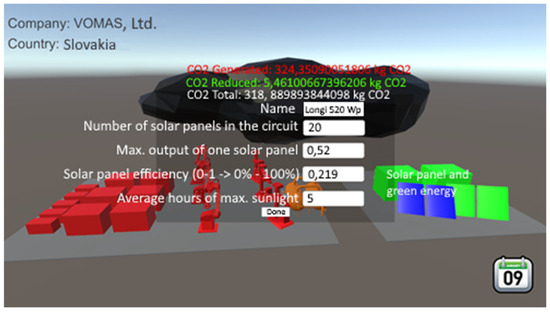
Figure 24.
Data for simulating the impact of solar panels on company CO2 emissions.
- Scope 2 Calculations
From Table 11 (Activity data: Scope 2), we can extract the necessary data for the calculation of Scope 2 emissions.
Laser Cutting Machine:
CO2 emissions = Total energy consumption × Utilization × Emission factor
CO2 emissions = 1.287 kWh × 90% × 32.68 × 0.352 kg CO2/kWh
CO2 emissions = 13.34 kg CO2
Smoke and Dust Extractor:
CO2 emissions = Total energy consumption × Utilization × Emission factor
Operating time = 32.68 h
CO2 emissions = 7.5 kWh × 5.96% × 100% × 32.68 × 0.352 kg CO2/kWh
CO2 emissions = 5.14 kg CO2
Cooler:
CO2 emissions = Total energy consumption × Utilization × Emission factor
Operating time = 32.68 h
CO2 emissions = 28 kWh × 5.96% × 100% × 32.68 h × 0.352 kg CO2/kWh
CO2 emissions = 19.20 kg CO2
Press Brake:
CO2 emissions = Total energy consumption × Utilization × Emission factor
Operating time = 5000 pcs/200 pcs per hour = 25 h
CO2 emissions = 11 kWh × 70% × 25 h × 0.352 kg CO2/kWh
CO2 emissions = 67.76 kg CO2
Total Scope 2 Emissions:
Total Scope 2 emissions = 13.34 kg CO2 + 5.14 kg CO2 + 19.20 kg CO2 + 67.76 kg CO2
Total monthly Scope 2 CO2 emissions of VOMAS, s.r.o. are = 105.44 kg CO2
- Scope 1 Calculations
From Table 10 (Activity data: Scope 1), we can extract the necessary data for the calculation of Scope 1 emissions.
Stationary Combustion (Natural Gas)
CO2 emissions = Natural gas consumption × Emission factor
403 kWh × 0.181234216 kg CO2e/kWh = 73.05 kg CO2e
Mobile Combustion (Petrol)
CO2 emissions = Petrol consumption × Emission factor
540 L × 2.328379026 kg CO2e/L = 1257.33 kg CO2e
Total Scope 1 Emissions
Total Scope 1 emissions = 73.05 kg CO2e + 1257.33 kg CO2e
Total monthly Scope 1 CO2 emissions of VOMAS, s.r.o. are 1330.38 kg CO2e
- Calculation of the Company’s Total Monthly Emissions
Scope 1 of the Current Production Process: To quantify the impact of Scope 1 emissions on this specific production process, it is important to consider that these emissions are reported for the entire month, whereas the model production process does not involve continuous monthly production. Therefore, we have decided to treat Scope 1 emissions as linearly distributed with a constant rate throughout the entire working month. Their share in the production process is then quantified based on time dependency.
The calculation is performed as follows:
- Number of Working Days in the Month (June): 25 days
- Number of Working Hours per Day: 8 h
- Production Duration: 32.68 h (4.0849673 working days)
- Total Number of Working Hours per Month
- Total hours = Number of working days × Number of working hours per day
- Total hours = 200 working hours
Process Share in Monthly Working Time
Process hours/Total monthly working hours × 100
32.68/200 = 16.34%
Proportional CO2 Emissions of the Production Process
Proportional CO2 emissions of the production process = Share of the process in the monthly working time × Total Scope 1 emissions
Proportional CO2 emissions = 16.34% of 1330.38 kg CO2e = 217.38 kg CO2e
Thus, under the given conditions, the Scope 1 emissions of the model production process amount to 217.38 kg CO2e.
Total Generated Emissions
Total CO2 emissions = Total Scope 1 emissions + Total Scope 2 emissions
Total emissions = 217.38 + 105.44 = 322.82 kg CO2e
Total emissions = 322.82 kg CO2e
Emission Reduction Calculations
Electricity generation = Number of solar panels × Installed capacity per panel × Efficiency × Average maximum solar radiation per hour × (Simulation duration/24)
Electricity generation = 20 × 0.52 kWh × 21.9% × 5/24 × 32.68
Electricity generation = 15.5065 kWh
Reduced Emissions = 15.50653595 × 0.352 kgCO2/kWh = 5.45830 kg CO2
Final Total Emissions
Final CO2 emissions = Generated emissions − Reduced emissions
Final emissions = 322.82 kg CO2e − 5.4583 kg CO2e = 317.36 kg CO2e
Data Comparison
Below (Table 15) is a comparison of the emission data generated by VOMAS, Ltd. during the production of 5000 pieces of trailer reinforcement plate holders. It can be observed that the emissions from the production process itself are negligible compared to the Scope 1 carbon emissions. However, when considering only Scope 2 emissions, the impact of solar panels on the overall emission share becomes significant. (Figure 25)

Table 15.
Comparison of calculations.
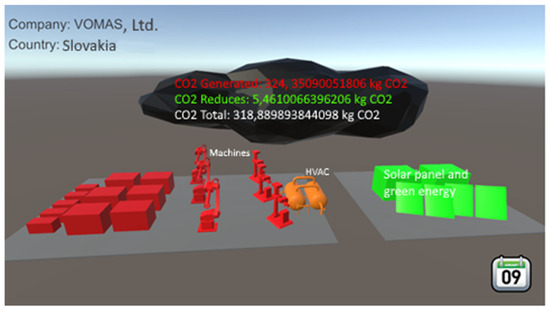
Figure 25.
Visual representation of key emission indicators.
4. Discussion
In Figure 26, Figure 27, Figure 28 and Figure 29, the results of the SustainSIM Summaries application are presented. First, a summary and analysis of the current production processes is provided, followed by a simulation of the application of solar panels. Subsequently, various scenarios for the implementation of green technologies are simulated, examining their impact on the carbon footprint.
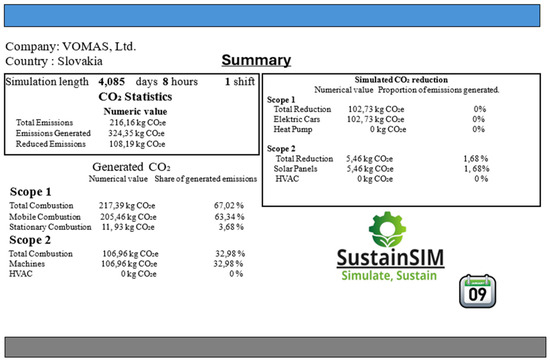
Figure 26.
Simulation summary: Scope 2 solar panel implementation.
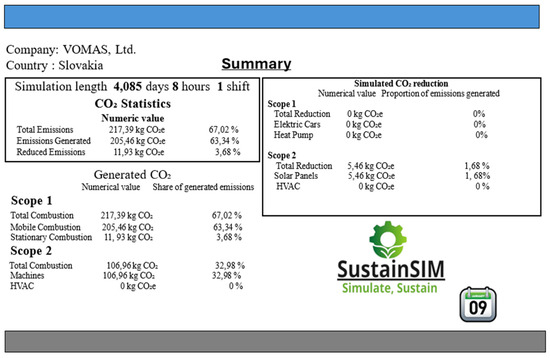
Figure 27.
Summary: Scope 1 and Scope 2 emissions with solar panels.
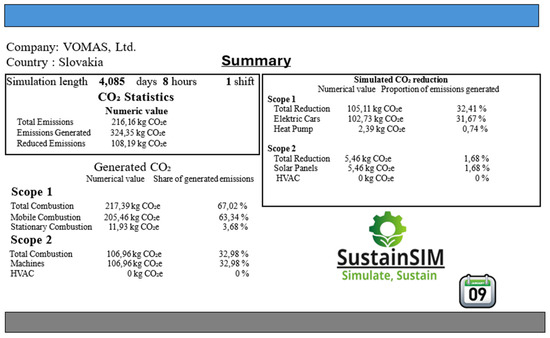
Figure 28.
Summary of the simulation: replacing one of two motor vehicles with electric vehicles.
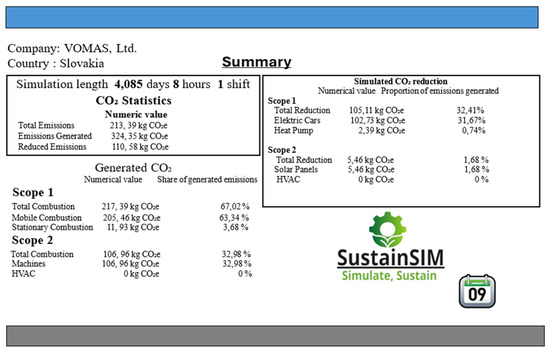
Figure 29.
Summary of the simulation with a more efficient heating system using a coefficient of performance.
It was observed that solar panels of this type and in this quantity are capable of reducing the net Scope 2 emissions generated by the production of the trailer reinforcement rod holder by 5.11%. In numerical terms, this represents 5.46 kg CO2e, or approximately 1/20 of the total emissions produced by manufacturing the product. Over the long term, this reduction can amount to several tons, considering that our simulation covered only a single process over four standard working days, and used solar panels that are not among the most efficient.
When replacing one of the company’s two vehicles with an electric vehicle, it can be observed that the impact is greater, as the CO2 emissions reduction with an electric vehicle compared to mobile combustion is as high as 100%.
When implementing a more efficient heating system, such as a heat pump, it can be observed that the impact on emissions is minimal. However, it could have favorable effects in terms of cost savings, although these implications go beyond the scope of the proposed application.
Figure 30 illustrates a bar chart with the comparison of emissions generated and CO2 reduction achieved across four different simulation scenarios. These include the application of solar panels, combined Scope 1 and Scope 2 emissions with solar implementation, substitution of a conventional vehicle with an electric vehicle, and modernization of the heating system. Each scenario is represented by two bars: one showing the total emissions in kilograms of CO2, and the other indicating the amount reduced due to the intervention.
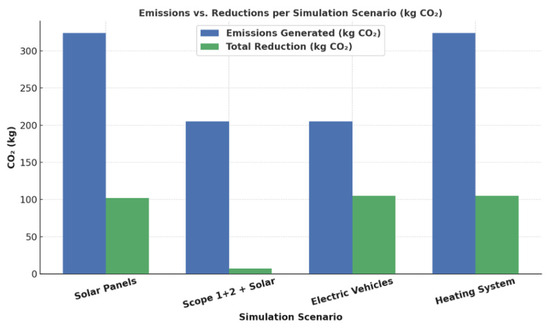
Figure 30.
Summary of Simulation Scenarios.
5. Conclusions
The benefits of the SustainSIM application are not only quantifiable but also highly practical, helping companies closely monitor how individual manufacturing activities influence overall CO2 emissions. This contributes to long-term carbon accounting improvements and the identification of the most effective sources of emission reductions. Thanks to interactive visualization, managers can track in real time how green technologies (e.g., solar panels, electric vehicles, and heat pumps) impact emission values, supporting them in strategic decision-making regarding production process optimization. The model provides in-depth analysis, which helps reduce energy costs and improve operational efficiency by enabling better planning and quicker adaptation to changing market and environmental conditions. Compliance with international standards and regulations, along with the ability to integrate with existing databases and systems, enhances the company’s competitive position on the global market.
In comparison with current methods, it has been confirmed that the application reduces analysis time to one-tenth of that required by LCA software, allowing companies to make data-driven decisions even before committing capital. A pilot deployment at VOMAS, Ltd. confirmed the potential for a 30% reduction in Scopes 1/2 with reasonable investment and indicated that SustainSIM can serve as the “missing link” between strategic ESG objectives and everyday production management. By extending traditional emission calculators with a digital twin in Unity, SustainSIM represents innovative and practically inimitable software, all within a single user interface.
The SustainSIM application can therefore serve as a valuable tool for engineering companies focused on sustainable production process optimization and committed to continuous improvement in sustainability efforts.
The objective of this publication was to present the development of a universal simulation application for emissions in engineering production. Based on the results of this work, we can conclude that the objective was met, as the model was successfully applied to a specific production process in an engineering company, and the obtained results aligned with expectations.
The SustainSIM application also includes a data analysis tool, allowing for the comparison of different green technologies. The resulting data clearly demonstrate their impact on reducing the carbon footprint of the production process. However, the model still offers room for improvement, as many data points had to be extracted from activity records through manual calculations. In the future, these data could be automatically processed by the software, ensuring a seamless and user-friendly experience for companies optimizing and monitoring the carbon footprint of manufacturing processes.
Further generative functions could be implemented, such as automated generation of production halls, integration with emission databases, and Scope 3 emission simulation. However, these additions exceed the current development scope, as the application remains under development.
Therefore, further development is aimed at automatic integration with ERP, IoT, and expansion to Scope 3. It also includes the addition of financial indicators (NPV, IRR) directly within the simulation interface. This will make the application an even more effective tool for industrial sustainability.
It can be concluded that a universally applicable digital reference and simulation model has been successfully created. The implementation of such a model could help executives and managers make more sustainable decisions. Further development of the application could expand its capabilities beyond emissions analysis to include economic evaluations of green projects and their associated emissions, significantly increasing the overall value of the universal digital reference model.
Author Contributions
Conceptualization: J.K., J.S. and P.M.; methodology: J.S.; software: R.S. and E.V.; validation: P.M. and J.K.; formal analysis: E.V.; data curation: J.K. and J.S.; writing—original draft preparation: J.K. and P.M.; writing—review and editing: E.V., J.K. and J.S.; visualization: J.K., R.S. and P.M.; supervision: J.S. and J.K. All authors have read and agreed to the published version of the manuscript.
Funding
VEGA 1/0383/25, KEGA 020TUKE-4/2023, KEGA 043TUKE-4/2024, KEGA 003TUKE-4/2024, VEGA 1/0508/22, APVV-17-0258, APVV-19-0418.
Institutional Review Board Statement
Not applicable.
Informed Consent Statement
Not applicable.
Data Availability Statement
The original contributions presented in this study are included in the article. Further inquiries can be directed to the corresponding author.
Conflicts of Interest
The authors declare no conflict of interest.
References
- Yang, Y.; Du, Y. Impact of technological innovation on CO2 emissions and emissions trend prediction on ‘New Normal’ economy in China. Atmos. Pollut. Res. 2019, 10, 152–161. [Google Scholar]
- Bukhari, H.; Basingab, M.S.; Rizwan, A.; Sanchez-Chero, M.; Pavlatos, C.; Vallejos More, L.A.; Fotis, G. Sustainable green supply chain and logistics management using adaptive fuzzy-based particle swarm optimization. Sustain. Comput. Inform. Syst. 2025, 46, 101119. [Google Scholar] [CrossRef]
- Fani, V.; Bucci, I.; Bandinelli, R.; Ribeiro da Silva, E. Sustainable reverse logistics network design using simulation: Insights from the fashion industry. Clean. Logist. Supply Chain 2025, 14, 100201. [Google Scholar] [CrossRef]
- Chen, X.; Zhang, C. A dynamic analysis of a green closed-loop supply chain with different on-line platform smart recycling and selling models. Comput. Ind. Eng. 2025, 200, 110748. [Google Scholar] [CrossRef]
- Lobus, N.V.; Knyazeva, M.A.; Popova, A.F.; Kulikovskiy, M.S. Carbon Footprint Reduction and Climate Change Mitigation: A Review of the Approaches, Technologies, and Implementation Challenges. J. Carbon Res. 2023, 9, 120. [Google Scholar] [CrossRef]
- EN 14181:2014; Stationary Source Emissions—Quality Assurance of Automated Measuring Systems. European Committee for Standardization: Brussels, Belgium, 2014.
- World Business Council for Sustainable Development; World Resources Institute. The GHG Protocol Corporate Accounting and Reporting Standard; World Resources Institute, Ed.; WBCSD/WRI: Geneva, Switzerland, 2004; ISBN 10: 1569735689. [Google Scholar]
- Castelluccio, S.; Fiore, S.; Comoglio, C. Evaluating GHG Emissions and Renewable Energy Use in the Italian Energy Sector: Monitoring, Reporting, and Objectives. Environments 2025, 12, 55. [Google Scholar] [CrossRef]
- GHG Protocol and Carbon Trust team. Technical Guidance fo Calculationg Scope 3 Emissions (Version 1.0), Supplement to the Corporate Value Chain (Scope 3), Accounting & Reporting Standard. s.l.: GHG Protocol. 2013. Available online: https://ghgprotocol.org (accessed on 24 February 2025).
- Yan, X.; Wang, L.; Fang, M.; Hu, J. How Can Industrial Parks Achieve Carbon Neutrality? Literature Review and Research Prospect Based on the CiteSpace Knowledge Map. Sustainability 2023, 15, 372. [Google Scholar] [CrossRef]
- Ou, S.; Chien, Y.; Hsu, C.; Ning, F.; Pan, H. The Ideal Strategy of Carbon-Neutral for Park Landscape Design: A Proposal for a Rapid Detection Method. Appl. Sci. 2024, 14, 8128. [Google Scholar] [CrossRef]
- Josimović, B.; Manić, B.; Niković, A. Environmental Protection in the Planning of Large Solar Power Plants. Appl. Sci. 2024, 14, 6043. [Google Scholar] [CrossRef]
- Sarkar, B.; Omair, M.; Choi, S.-B. A Multi-Objective Optimization of Energy, Economic, and Carbon Emission in a Production Model under Sustainable Supply Chain Management. Appl. Sci. 2018, 8, 1744. [Google Scholar] [CrossRef]
- Rus, T.; Moldovan, R.-P.; Beu, D.; Pop, M.; Ceclan, A. Towards a Climate-Neutral Campus: Carbon Footprint Assessment in Higher Education Institutions. Appl. Sci. 2025, 15, 3695. [Google Scholar] [CrossRef]
- Karkhanis, E.; Kaushal, V.; Thakre, G.; Najaf, M. A Comprehensive Analysis of Environmental Emissions from Trenchless CIPP and Excavation Technologies for Sanitary Sewers. Appl. Sci. 2025, 15, 1268. [Google Scholar] [CrossRef]
- Kolendo, G.; Voronova, V.; Bumanis, G.; Korjakins, A.; Bajare, D. Life Cycle Assessment of End-of-Life Tire Disposal Methods and Potential Integration of Recycled Crumb Rubber in Cement Composites. Appl. Sci. 2024, 14, 11667. [Google Scholar] [CrossRef]
- Kishor, K.; Rani, R.; Rai, A.K.; Sharma, V. 3D Application Development Using Unity Real-Time Platform. In Proceedings of the Fourth Doctoral Symposium on Computational Intelligence (DoSCI 2023), Lucknow, India, 17 September 2023; pp. 665–675. [Google Scholar]
- Bastos, J.; Monforti-Ferrario, F.; Melica, G. Emission Factors for Electricity Consumption; Joint Research Centre (JRC): Brussels, Belgium, 2024. [Google Scholar]
- Rivera, A.; Movalia, S.; Rutkowski, E.; Rangel, Y.; Pitt, H.; Larsen, K. Global Greenhouse Gas Emissions: 1990–2021 and Preliminary 2022. Available online: https://rhg.com/research/global-greenhouse-gas-emissions-2022/ (accessed on 31 March 2025).
- Snyder, A. GHG Protocol. Available online: https://ghgprotocol.org/ (accessed on 28 March 2025).
Disclaimer/Publisher’s Note: The statements, opinions and data contained in all publications are solely those of the individual author(s) and contributor(s) and not of MDPI and/or the editor(s). MDPI and/or the editor(s) disclaim responsibility for any injury to people or property resulting from any ideas, methods, instructions or products referred to in the content. |
© 2025 by the authors. Licensee MDPI, Basel, Switzerland. This article is an open access article distributed under the terms and conditions of the Creative Commons Attribution (CC BY) license (https://creativecommons.org/licenses/by/4.0/).